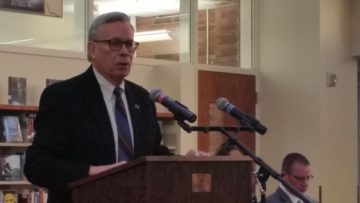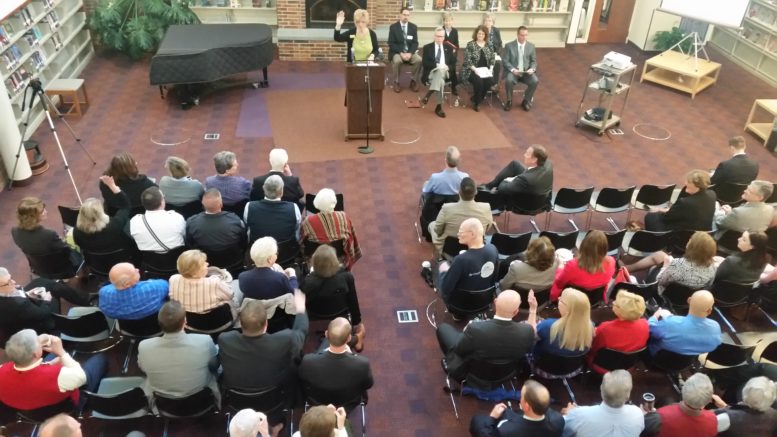By JAN LARSON McLAUGHLIN
BG Independent News
Bowling Green is making great strides in sustainable energy, has seen consistent job growth, and is making progress on some of the stickier issues in the community, Mayor Dick Edwards told the audience at the annual State of the City held this morning. And though some difficult issues await the city this year, the community is up to the challenge.
“I often find myself reflecting why the mechanisms and processes of government in Bowling Green seem to work so well over the years,” Edwards said at the chamber sponsored event in the county library. “In my view, and one that is commonly held, it is the continuing ability to work together, to find solutions to perceived needs that seem to work and to think ahead, to anticipate needs.”
The mayor praised the economic health of Bowling Green. “Our job growth continues to be one of the most robust of any city in the region and is integrally related to the city’s fiscal health,” Edwards said.
He spoke of progress in the city’s effort to use renewable energy, saying the city will soon have “the largest solar field of any city in Ohio.”

Mayor Dick Edwards
But challenges lie ahead. “We have a very full plate these days and some special challenges.” Those include:
- The “absolute must” passage of the park levy.
- The East Wooster Street corridor plan.
- Housing and neighborhood revitalization.
- Vehicular and pedestrian safety and the “new face” for the city at the new Interstate 75 interchange.
- Maintenance of a vibrant downtown.
- Finding a new home for municipal government offices in the downtown.
Municipal Administrator Lori Tretter talked about the safety and quality of life in the city – much of it funded through the city income tax. The 2 percent income tax, which supports the general fund and the sewer and water capital fund, has grown from $15.6 million in 2011 to $19.2 million this year.
“Bowling Green businesses are doing well and employment is robust,” Tretter said.
But the increase in the income tax revenue has been countered by the decrease in Local Government Funds and the elimination of estate taxes. Tretter asked City Finance Director Brian Bushong to characterize the health of the city finances, to which he replied, “the outlook is stable with cautious optimism.”
The city has several projects planned for 2016, including utility improvements and other infrastructure work.
“There will be a lot of community improvements,” she said. Tretter noted the city’s philosophy of fixing problems before they get too costly. “Allow the roads to crumble and you will spend significantly more to repair them.”
Council President Mike Aspacher spoke of the city’s future land use plan update which shows a “clear blueprint for the community.” The top three priorities in the plan are the East Wooster corridor, the green space area downtown, and improving housing and revitalizing neighborhoods.
“We made progress with all three of these initiatives,” Aspacher said.
The city is also facing decisions on an updated city building, Complete Streets program, future cemetery needs, sustainable energy and a historic preservation district.
“We look forward to addressing these challenges,” Aspacher said.
City Utilities Director Brian O’Connell talked about improvements to the water plant, and addition of a water tower on Newton Road. He mentioned the city will start selling water to the village of Waterville by the end of the year. That village is expected to use about 500,000 gallons a day.
The city wastewater plant recently received a favorable rating by the EPA, and efforts are being made to lessen odors from the site, he said.
O’Connell talked about the new solar project which will cover 145 acres northeast of the city. Upon completion of that, the city will get 38 percent of its energy from renewable sources of wind, hydro and solar.
Economic Development Director Sue Clark said the city is “economically steady,” with no huge gains or losses last year. Manufacturers, however, invested $50 million in machinery and equipment last year.
That willingness to invest is an “excellent indicator of the health” of city manufacturers, which now employ about 4,000 workers, she said.
The largest investment last year was made by Phoenix Technologies, which spent $16 million at its new East Poe Road site.
Commercial and retail also saw growth, with Kroger expanding and a Fairfield Inn being constructed. Other commercial businesses are showing interest in the city, Clark said.
“We have finally gained some respect,” that has long gone to Perrysburg and Findlay, but skipped Bowling Green, she said.
But some problems remain, including a lack of qualified employees to fill manufacturing jobs, Clark said. The city has an unemployment rate of 3.7 percent, which makes it difficult to find employees. Some manufacturers have told Clark that they are turning away work because they can’t local qualified workers.
Also speaking was Sheri Stoll, chief financial officer for Bowling Green State University, who said while enrollment has posed challenges in recent years, it is now trending upward.
Decreases in state funding continue to be a problem for BGSU. In 2006, the university got $77 million from the state, which made up 33 percent of its budget. This year, BGSU will get $68 million from the state, which is 22 percent of its general operating budget.
“The difference is obviously coming from students and their families,” Stoll said.
The general operating budget has stayed consistent for 10 years, despite rising costs. “We have had to find a profound number” of ways to cut costs and be more efficient, Stoll said.
BGSU is continuing to invest in its faculty, academic programs and physical campus, with $300 million in capital improvements being completed recently, and another $300 million planned for the next five to seven years.
“Our successful future and the successful future of the city are inextricably linked,” Stoll said.

